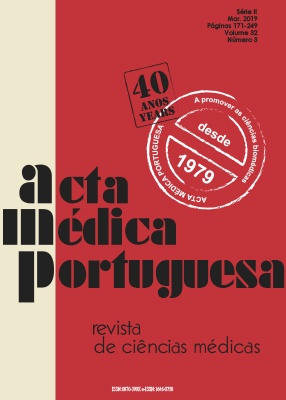Addictive Video Game Use: An Emerging Pediatric Problem?
DOI:
https://doi.org/10.20344/amp.10985Keywords:
Behavior, Addictive, Child, Video GamesAbstract
Introduction: The excessive use of video games is an emerging problem that has been studied in the context of addictive behaviors. The aim of this study was to determine the prevalence of use of addictive video games in a group of children and to identify risk factors, protective factors and potential consequences of these behaviors.
Material and Methods: Observational and cross-sectional study of children from the sixth grade using an anonymous questionnaire. Addictive video game use was defined by the presence of 5 out of 9 behavioral items adapted from the DSM-5 criteria for ‘Pathological gambling’. Children who answered ‘yes’ to 4 items were included in the “Risk group for addictive video game use”. We delivered 192 questionnaires and 152 were received and included in the study (79.2% response rate). SPSS statistical software was used.
Results: Half of the participants were male and the median age was 11 years old. Use of addictive video games was present in 3.9% of children and 33% fulfilled the risk group criteria. Most children played alone. We found additional factors associated with being in the risk group: greater time of use; online, action and fighting games (p < 0.001). Children with risk behaviors showed a shorter sleep duration (p < 0.001).
Discussion: A significant number of children of our sample met criteria for addictive video games use in an early age and a greater number may be at risk (33%). This is a problem that warrants further research and clinical attention.
Conclusion: This exploratory study helps to understand that addiction to video games in children is an emergent problem.
Downloads
Downloads
Published
How to Cite
Issue
Section
License
All the articles published in the AMP are open access and comply with the requirements of funding agencies or academic institutions. The AMP is governed by the terms of the Creative Commons ‘Attribution – Non-Commercial Use - (CC-BY-NC)’ license, regarding the use by third parties.
It is the author’s responsibility to obtain approval for the reproduction of figures, tables, etc. from other publications.
Upon acceptance of an article for publication, the authors will be asked to complete the ICMJE “Copyright Liability and Copyright Sharing Statement “(http://www.actamedicaportuguesa.com/info/AMP-NormasPublicacao.pdf) and the “Declaration of Potential Conflicts of Interest” (http:// www.icmje.org/conflicts-of-interest). An e-mail will be sent to the corresponding author to acknowledge receipt of the manuscript.
After publication, the authors are authorised to make their articles available in repositories of their institutions of origin, as long as they always mention where they were published and according to the Creative Commons license.









